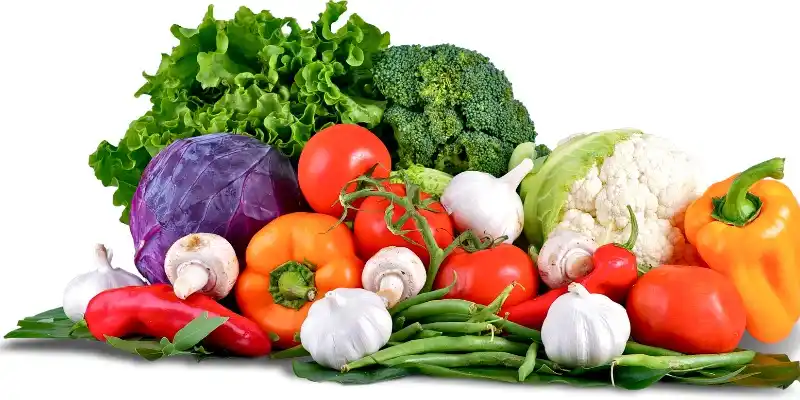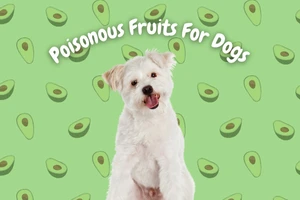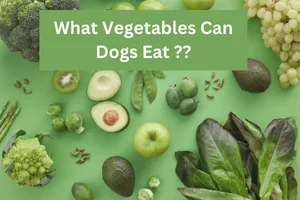Can Dogs Eat Vegetables? A Comprehensive Guide
Published: 4 Nov 2024
Can dogs eat vegetables? This question often leaves pet owners puzzled. While some vegetables offer significant health benefits, others can be harmful or toxic. Knowing the difference is crucial to keeping your dog happy and healthy.
In this article, we’ll explore which vegetables are safe for dogs, how they can boost your dog’s health, and which ones you should avoid altogether. We’ll also cover the right portions to feed and the best ways to introduce veggies into your dog’s diet.
By the end, you’ll know exactly what to put in their bowl to keep them healthy and safe.
Keep reading to discover how to make sure your dog enjoys the right veggies!
Can Dogs Eat Vegetables?
Yes, dogs can have vegetables! They can be a healthy addition to your dog’s diet. They aren’t the main food, but they are packed with vitamins, minerals, and fiber, aiding digestion and boosting the immune system. However, always introduce new vegetables slowly and make sure they’re cooked or chopped to avoid choking hazards.

Let’s move further and discover safe and toxic vegetables!
Safe Vegetables for Dogs
When it comes to keeping your dog healthy, adding safe vegetables to their diet can be a great choice. Many veggies are not only tasty for dogs but also provide essential nutrients that keep your dog healthy and strong.
Here’s a list of safe vegetables that you can feed your furry friend:
- Carrots
- Green Beans
- Peas
- Sweet Potatoes
- Pumpkin
- Broccoli
- Cauliflower
- Spinach
- Zucchini
- Cucumber
- Bell Peppers (all colors)
- Celery
- Radishes
- Asparagus
- Brussels Sprouts
- Beet Greens
- Eggplant
- Mushrooms
- Kale

Explore the benefits of each vegetable in our article “Safe Vegetables for Dogs.“
Vegetables Dogs Should Avoid
While many vegetables are safe for dogs, some can be harmful or even toxic. Here’s a list of vegetables that dogs should avoid:
- Onions
- Garlic
- Leeks
- Chives
- Wild Mushrooms
- Rhubarb
- Raw Potatoes
- Green parts of Tomatoes

Learn the details of each toxic vegetable in our article “Poisonous Vegetables For Dogs.“
Can Puppies Eat Vegetables?
Yes, puppies can safely eat vegetables, but their dietary needs are different from those of adult dogs. Puppies require more protein, fat, and calories to support their growth, so vegetables should only be a small part of their diet.
Safe options like carrots, green beans, and sweet potatoes can provide fiber and vitamins, but they should never replace balanced puppy food. Always introduce vegetables slowly and cut them into small pieces to prevent choking. Consult a vet before adding new foods to ensure they’re safe for your puppy’s age and health.
Why Vegetables Are Good for Dogs?
Vegetables are a fantastic addition to your dog’s diet. They can enhance meals and provide extra health benefits.
Let’s explore their benefits together!
- Rich in Nutrients: Vegetables are packed with essential vitamins (like A, C, and K) and minerals (like calcium and potassium) that support the heart, blood vessels, and nervous system.
- High in Fiber: Fiber in vegetables helps with digestion and can keep your dog’s gut healthy. It also helps prevent constipation and can promote a feeling of fullness.
- Low in Calories: Most vegetables are low in calories, making them a great snack option for dogs that need to maintain a healthy weight.
- Hydration: Many vegetables have high water content, which can help keep your dog hydrated.
- Antioxidants: Vegetables contain antioxidants that fight free radicals in the body. This can help reduce the risk of chronic diseases and support healthy aging.
- Variety in Diet: Adding different vegetables can provide variety in your dog’s meals, keeping them excited about their food.
By incorporating safe vegetables into your dog’s diet, you can help them enjoy these benefits while keeping their meals exciting and nutritious!
What Happens If a Dog Eats Toxic Vegetables?
If a dog eats a toxic vegetable, they may experience a range of symptoms depending on the type and amount ingested. Common signs include:
| Signs of Vegetable Toxicity in Dogs |
|---|
|
If you suspect your dog has eaten a toxic vegetable, contact your vet immediately for advice or visit an emergency animal clinic. Early intervention can help prevent serious health problems.
How to Add Vegetables to Your Dog’s Diet?
Introducing vegetables to your dog’s diet can be a fun and healthy experience. Here are some tips to help you do it safely:
- Start Slowly: Add a small amount of one vegetable at a time to your dog’s meals. This will allow their digestive system to adjust and help you monitor any reactions.
- Cook or Steam: Cooking or steaming vegetables can make them easier for your dog to digest. Avoid adding seasoning or oils, as these can harm dogs.
- Chop or Mash: Cut vegetables into small pieces or mash them for smaller dogs to make them easier to eat and prevent choking.
- Watch for Allergies: After introducing new vegetables, monitor your dog for signs of allergies, such as itching, swelling, or gastrointestinal upset. Stop feeding the new veggie and consult your vet if you notice any unusual symptoms.
- Monitor Digestive Issues: Pay attention to your dog’s stool and behaviour after feeding vegetables. If you notice diarrhoea, bloating, or gas, it may be a sign that your dog isn’t tolerating the new food well.
By following these tips, you can safely introduce vegetables to your dog’s diet and discover which ones they enjoy the most!
How Many Vegetables Should a Dog Eat?
Vegetables are a great source of fibre, vitamins, and minerals. However, they should only make up about 10% of your dog’s daily intake. The rest of their diet should be primarily protein-based.
For small dogs (under 20 lbs), 1-2 tablespoons of cooked or finely chopped raw vegetables per day is enough. Medium dogs (20-50 lbs) can have 2-4 tablespoons. Large dogs (over 50 lbs) can safely enjoy ½ cup to 1 cup of veggies daily. Balance vegetable intake with other food groups to avoid overloading your dog with fibre, which can cause digestive issues.
Use “The Dog Calorie Calculator” to calculate how much should a dog eat.
Creative Ways to Serve Vegetables to Dogs
If your dog is a picky eater or doesn’t like vegetables, you can serve them in fun ways to make them appealing. Here are some creative ways to serve vegetables to dogs:
| Fun Vegetable Treats |
|---|
|
These methods make vegetables more fun and appealing for your dog while still delivering essential nutrients!
Should You Serve Veggies Raw or Cooked?
When deciding whether to serve vegetables to your dog raw or cooked, weighing the benefits of each is essential. Raw veggies are packed with nutrients and provide a crunchy texture that can support dental health, while cooked vegetables are easier to digest and often more flavorful.
Here’s a quick comparison to help you choose the best option for your dog:
| Raw Vegetables | Cooked Vegetables | |
|---|---|---|
| Nutritional Value | Higher in vitamins and minerals | More complicated to digest, especially for fibrous veggies |
| Digestibility | Harder to digest, especially for fibrous veggies | Easier to digest due to softened fibers |
| Texture | Crunchy, good for dental health | Soft, appealing to dogs who prefer tender textures |
| Safety | Some veggies are hard to chew or may cause choking | Cooking eliminates toxins (e.g., in potatoes) |
| Flavor | Less intense, may be less appealing to picky dogs | Easier to digest due to softened fibres |
| Examples | Carrots, bell peppers, cucumbers | Sweet potatoes, broccoli, green beans |
| Best For | Dogs who enjoy crunch and raw textures | Dogs with sensitive stomachs or who prefer softer food |
I believe that it’s easier now for you to decide what’s best for your pup!
Conclusion:
So, guys, your confusion about “Can Dogs Eat Vegetables?” has been solved now. We covered everything from safe and toxic veggies to portion sizes, creative serving ideas, and the benefits of raw versus cooked vegetables.
From my experience, I recommend starting with simple, safe options like steamed sweet potatoes or raw cucumber slices. Your dog will likely love the variety, but remember to keep it in moderation. If you’re looking for more tips on keeping your dog healthy and happy, check out our other articles or talk to your vet for personalized advice. Your dog’s health is worth the extra effort!
FAQs
Here is a list of some questions that might arise in your mind.
Most dogs can enjoy vegetables, but it’s important to introduce them gradually and monitor for any allergic reactions. Some dogs may have sensitivities, so always consult your vet before adding new foods. Stick to dog-safe veggies to ensure their health.
Watch your dog’s reactions when you introduce new vegetables. If they eagerly eat them, they likely enjoy them! However, if they turn their nose up or refuse to eat them, they may not be fans.
You can give your dog vegetable scraps, but ensure they are safe and free from seasonings or additives. Always check that the scraps are from dog-safe veggies. It’s best to prepare fresh vegetables specifically for your dog’s meals.
Raw vegetables retain more nutrients, but they can be harder to digest for some dogs. Cooking vegetables soften their fibres, making them easier to digest. It’s best to see what your dog prefers and monitor their digestive health.
Try incorporating veggies into their meals as a topper or mix them with their favourite foods. You can also serve them in fun ways, like making veggie popsicles or mashed veggie treats. Be patient and experiment with different vegetables to find what they enjoy.
Yes, frozen vegetables can be a crunchy and refreshing treat for dogs, especially during hot weather. Please make sure they are safe and serve them in moderation. Always thaw or cook larger pieces to avoid choking hazards.
If your dog shows signs of an allergic reaction, like itching, swelling, or gastrointestinal upset, stop feeding them the vegetable immediately. Monitor their symptoms and contact your vet for advice. It’s always best to consult a professional if you’re concerned about your dog’s health.

- Be Respectful
- Stay Relevant
- Stay Positive
- True Feedback
- Encourage Discussion
- Avoid Spamming
- No Fake News
- Don't Copy-Paste
- No Personal Attacks

- Be Respectful
- Stay Relevant
- Stay Positive
- True Feedback
- Encourage Discussion
- Avoid Spamming
- No Fake News
- Don't Copy-Paste
- No Personal Attacks





